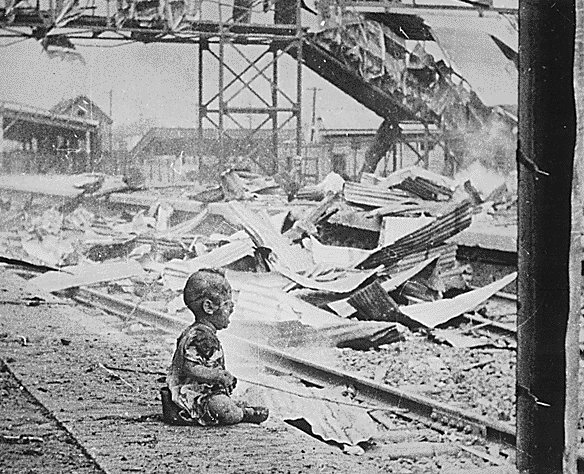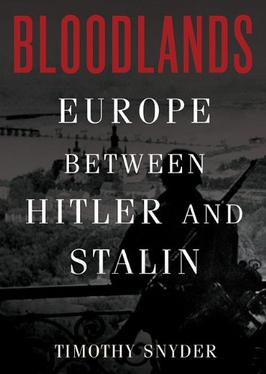
“Boys from another school pulled out the severed head of a classmate while fishing in a pond. His whole family had died. Had they eaten him first? Or had he survived the deaths of his parents only to be killed by a cannibal? No one knew; but such questions were commonplace for the children of Ukraine in 1933. . . . Yet cannibalism was, sometimes, a victimless crime. Some mothers and fathers killed their children and ate them. ... But other parents asked their children to make use of their own bodies if they passed away. More than one Ukrainian child had to tell a brother or sister: ‘Mother says that we should eat her if she dies.’ ”
— Timothy Snyder, “Bloodlands: Europe Between Hitler and Stalin” (2010)
Timothy D. Snyder: http://en.wikipedia.org/wiki/Timothy_D._Snyder
***

Russia’s brutality with Ukraine is nothing new
George F. Will
While Vladimir Putin, Stalin’s spawn, ponders what to do with what remains of Ukraine, remember: Years before the January 1942 Wannsee Conference, at which the Nazis embarked on industrialized genocide, Stalin deliberately inflicted genocidal starvation on Ukraine.
To fathom the tangled forces, including powerful ones of memory, at work in that singularly tormented place, begin with Snyder’s stunning book. Secretary of State John Kerry has called Russia’s invasion of Ukraine “a 19th-century act in the 21st century.” Snyder reminds us that “Europeans deliberately starved Europeans in horrific numbers in the middle of the 20th century.” Here is Snyder’s distillation of a Welsh journalist’s description of a Ukrainian city:
“People appeared at 2 o’clock in the morning to queue in front of shops that did not open until 7. On an average day 40,000 people would wait for bread. Those in line were so desperate to keep their places that they would cling to the belts of those immediately in front of them. . . . The waiting lasted all day, and sometimes for two. . . . Somewhere in line a woman would wail, and the moaning would echo up and down the line, so that the whole group of thousands sounded like a single animal with an elemental fear.”
This, which occurred about as close to Paris as Washington is to Denver, was an engineered famine, the intended result of Stalin’s decision that agriculture should be collectivized and the “kulaks” — prosperous farmers — should be “liquidated as a class.” In January 1933, Stalin, writes Snyder, sealed Ukraine’s borders so peasants could not escape and sealed the cities so peasants could not go there to beg. By spring, more than 10,000 Ukrainians were dying each day, more than the 6,000 Jews who perished daily in Auschwitz at the peak of extermination in the spring of 1944.
Soon many Ukrainian children resembled “embryos out of alcohol bottles” (Arthur Koestler’s description) and there were, in Snyder’s words, “roving bands of cannibals”: “In the villages smoke coming from a cottage chimney was a suspicious sign, since it tended to mean that cannibals were eating a kill or that families were roasting one of their members.”
Snyder, a Yale historian, is judicious about estimates of Ukrainian deaths from hunger and related diseases, settling on an educated guess of approximately 3.3 million, in 1932-33. He says that when “the Soviet census of 1937 found 8 million fewer people than projected,” many of the missing being victims of starvation in Ukraine and elsewhere (and the children they did not have), Stalin “had the responsible demographers executed.”
Putin, who was socialized in the Soviet-era KGB apparatus of oppression, aspires to reverse the Soviet Union’s collapse, which he considers “the greatest geopolitical catastrophe of the [20th] century.” Herewith a final description from Snyder of the consequences of the Soviet system, the passing of which Putin so regrets:
“One spring morning, amidst the piles of dead peasants at the Kharkiv market, an infant suckled the breast of its mother, whose face was a lifeless gray. Passersby had seen this before . . . that precise scene, the tiny mouth, the last drops of milk, the cold nipple. The Ukrainians had a term for this. They said to themselves, quietly, as they passed: ‘These are the buds of the socialist spring.’ ”
U.S. policymakers, having allowed their wishes to father their thoughts, find Putin incomprehensible. He (Putin) is a barbarian but not a monster, and hence no Stalin. But he has been coarsened, in ways difficult for civilized people to understand, by certain continuities, institutional and emotional, with an almost unimaginably vicious past. And as Ukraine, a bubbling stew of tensions and hatreds, struggles with its identity and aspirations, Americans should warily remember William Faulkner’s aphorism: “The past is never dead. It’s not even past.”
* * *
Note: I wish to apologize to the New York Times for inadvertently reproducing in my March 13 column without attribution 12 words from an October 2007 Times story describing the 1971 Bon Vivant botulism and bankruptcy episode.
Read more from George F. Will’s archive
No comments:
Post a Comment